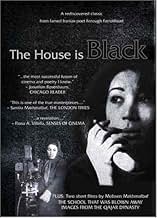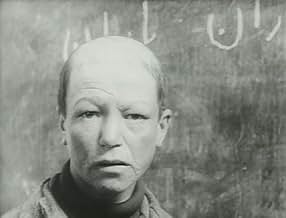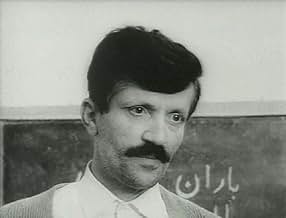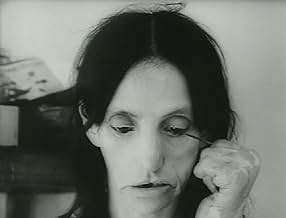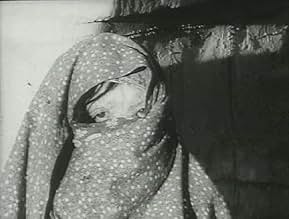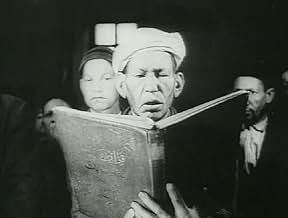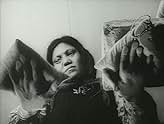IMDb RATING
7.8/10
5.9K
YOUR RATING
Set in a leper colony in the north of Iran, The House is Black juxtaposes "ugliness", of which there is much in the world as stated in the opening scenes, with religion and gratitude.Set in a leper colony in the north of Iran, The House is Black juxtaposes "ugliness", of which there is much in the world as stated in the opening scenes, with religion and gratitude.Set in a leper colony in the north of Iran, The House is Black juxtaposes "ugliness", of which there is much in the world as stated in the opening scenes, with religion and gratitude.
- Director
- Writer
- Stars
Forugh Farrokhzad
- Narrator
- (uncredited)
Ebrahim Golestan
- Narrator
- (uncredited)
Hossein Mansouri
- Self
- (uncredited)
- Director
- Writer
- All cast & crew
- Production, box office & more at IMDbPro
Featured reviews
10evolv
One must consider why the religious emphasis is there. Everyone in this film has a message; the Iranians are known for their no frills directness when it comes to film-making.What is Farrokhzad saying about religion?
Additionally; is this film entirely about leprosy, or does it hint toward other kinds of corruption?
Is the previous reviewer certain that there were scripted scenes? I admit it's been a while so I can't clearly remember; however another rule of Iranian film is that can be very hard to distinguish the scripted and the natural. If you want to test this, check out Kiarostami's wonderful "Close-up" or Samira Makhmalbaf's "Apple". The events are real as are the actors, beyond that...well just watch em. With your thinking hat on.
OK i'm done.
Additionally; is this film entirely about leprosy, or does it hint toward other kinds of corruption?
Is the previous reviewer certain that there were scripted scenes? I admit it's been a while so I can't clearly remember; however another rule of Iranian film is that can be very hard to distinguish the scripted and the natural. If you want to test this, check out Kiarostami's wonderful "Close-up" or Samira Makhmalbaf's "Apple". The events are real as are the actors, beyond that...well just watch em. With your thinking hat on.
OK i'm done.
This short makes my top 30 favorite films of all time. I didn't expect to love it as much as I did when I first saw it considering how poor the quality of the film is (in fact, there are a couple points where I can't make out the subtitles in the film due to how they blend in with the background). Given this, what did it do to impress me so much?
The line "Leprosy is not incurable" is repeated twice throughout an opening sequence which states facts about leprosy, almost as if to make sure the meaning of that line isn't lost concerning the grisly images we see of the people with the disease. Considering how the narrator points out how other people with the disease were cured when treated for it, this monologue also indicates that all the people we see suffering in the film could be cured of this disease. It's just that the government failed to take care of them as, instead of solving the problem, they herded them into the colony documented in the short, leaving them to further deteriorate. Instead of this scene coming off as preachy, this unspoken message is implied rather than directly stated, making for a really powerful scene. Regardless of whether you pick up on this implication or not, it still manages to get under your skin.
Farrokhzad also does a great job at exploring the ironies of the daily lives of the people in the colony, specifically with religion. Multiple sequences indicate that religion is a major part of their cultures. In one scene, a group of kids thank God for giving them hands, eyes, and ears - features which many people in the colony don't have. In another powerful moment, a man holds his withered hands in the air and refers to hands while reciting a prayer. This is followed by a sequence which cuts between a group of people practicing religion and several shots of people with deformed body parts which were brought about due to the disease, in turn creating tension with this editing technique. The viewer can't help but wonder why all these people thank God for giving them gifts which many of them don't have. It seems likely that religion is an abstract concept in their lives and they don't think much about the words and prayers they say.
In addition, a few sequences in the film stick out to me as especially powerful. The first of which shows a couple women putting on makeup and brushing their hair. This scene shows how, in spite of their facial and bodily features, many of the people in the colony still make an effort to look "beautiful", as if their goals are to connect with their past lives or to find light in such a depressing environment. Another scene shows a group of boys playing ball together. Unlike a number of the older people we see in the colony, their mobility doesn't seem to be effected by their disease. Despite this though, the grotesque facial features of a number of them are hard to ignore and, considering how the shot which immediately follows this sequence shows a man with one leg slowly walk down a path with the help of crutches, the short seems to suggest that those boys will grow up with further suffering and that they won't be able to experience moments like this unless they're cured of their disease (one effective shot which occurs earlier in the film shows a man giving his crutch to a boy to play with). One final scene worth mentioning is the classroom scene at the end. Something about this scene, specifically some of the answers the boys give to their teacher, makes it feel staged. It just seems too suited for the messages Farrokhzad wants to send to have naturally occurred. While I usually find staged scenes like this to be jarring in documentaries, I didn't mind it so much in here as it's still able to make for a devastating critique of religion.
Overall, this is a perfect short. Instead of solely raising awareness for the issue documented in it, Farrokhzad has several artistic points which she incorporates into the dialogue and the visuals of the film quite flawlessly as many of them are subtle or implied rather than directly stated. Sadly, Farrokhzad died shortly after this film was released, making this the only film she directed. Who knows what else she could've given us? However, this film will forever stand as a masterpiece to me and, if you can get by the occasional issues with the subtitles, you're in for a great treat with this one.
The line "Leprosy is not incurable" is repeated twice throughout an opening sequence which states facts about leprosy, almost as if to make sure the meaning of that line isn't lost concerning the grisly images we see of the people with the disease. Considering how the narrator points out how other people with the disease were cured when treated for it, this monologue also indicates that all the people we see suffering in the film could be cured of this disease. It's just that the government failed to take care of them as, instead of solving the problem, they herded them into the colony documented in the short, leaving them to further deteriorate. Instead of this scene coming off as preachy, this unspoken message is implied rather than directly stated, making for a really powerful scene. Regardless of whether you pick up on this implication or not, it still manages to get under your skin.
Farrokhzad also does a great job at exploring the ironies of the daily lives of the people in the colony, specifically with religion. Multiple sequences indicate that religion is a major part of their cultures. In one scene, a group of kids thank God for giving them hands, eyes, and ears - features which many people in the colony don't have. In another powerful moment, a man holds his withered hands in the air and refers to hands while reciting a prayer. This is followed by a sequence which cuts between a group of people practicing religion and several shots of people with deformed body parts which were brought about due to the disease, in turn creating tension with this editing technique. The viewer can't help but wonder why all these people thank God for giving them gifts which many of them don't have. It seems likely that religion is an abstract concept in their lives and they don't think much about the words and prayers they say.
In addition, a few sequences in the film stick out to me as especially powerful. The first of which shows a couple women putting on makeup and brushing their hair. This scene shows how, in spite of their facial and bodily features, many of the people in the colony still make an effort to look "beautiful", as if their goals are to connect with their past lives or to find light in such a depressing environment. Another scene shows a group of boys playing ball together. Unlike a number of the older people we see in the colony, their mobility doesn't seem to be effected by their disease. Despite this though, the grotesque facial features of a number of them are hard to ignore and, considering how the shot which immediately follows this sequence shows a man with one leg slowly walk down a path with the help of crutches, the short seems to suggest that those boys will grow up with further suffering and that they won't be able to experience moments like this unless they're cured of their disease (one effective shot which occurs earlier in the film shows a man giving his crutch to a boy to play with). One final scene worth mentioning is the classroom scene at the end. Something about this scene, specifically some of the answers the boys give to their teacher, makes it feel staged. It just seems too suited for the messages Farrokhzad wants to send to have naturally occurred. While I usually find staged scenes like this to be jarring in documentaries, I didn't mind it so much in here as it's still able to make for a devastating critique of religion.
Overall, this is a perfect short. Instead of solely raising awareness for the issue documented in it, Farrokhzad has several artistic points which she incorporates into the dialogue and the visuals of the film quite flawlessly as many of them are subtle or implied rather than directly stated. Sadly, Farrokhzad died shortly after this film was released, making this the only film she directed. Who knows what else she could've given us? However, this film will forever stand as a masterpiece to me and, if you can get by the occasional issues with the subtitles, you're in for a great treat with this one.
`There is no shortage of ugliness in the world.' the opening voice-over states as we see a horribly disfigured woman staring into a mirror. And by the film's end, we truly get an understanding of what she means.
`Khaneh siah ast' (The House is Black), written, directed and edited in 1963 by Forugh Farrokhzad is a brilliant piece of work done on an issue that has hardly been portrayed in any kind of film, fiction or non. Filmed in B&W on location somewhere on a Middle Eastern island, the film portrays a rapid series of events during the everyday lives of all of its inhabitants that are suffering from various stages of leprosy.
Cinematographer Soleiman Minasian uses mainly natural light and captures the pure essence of what living with leprosy is actually like. It is very startling. All the more startling due to Farrokhzad's rapid editing and cutting and disorienting flash-pans. And although the film is a documentary, there are certain scenes, which are entirely fabricated and contrived. One scene in particular is an actual tracking shot through a classroom where there is a coherent edited sequence of dialogue spoken between a teacher and his student. And although no one in the film is an actor, the scene was indeed scripted.
The reason the film is so brilliant is because Farrokhzad juxtaposes the images with extremely religious voice-over narration. Each individual that has leprosy prays to God and gives thanks for being alive in this world. It is harshly ironic that all living lepers are giving thanks and praise to a God that forces them to live through painful physical suffering everyday of their life.
They say leprosy is a curable disease, however, the impact and feeling you get from experiencing this film, is not.
`Khaneh siah ast' (The House is Black), written, directed and edited in 1963 by Forugh Farrokhzad is a brilliant piece of work done on an issue that has hardly been portrayed in any kind of film, fiction or non. Filmed in B&W on location somewhere on a Middle Eastern island, the film portrays a rapid series of events during the everyday lives of all of its inhabitants that are suffering from various stages of leprosy.
Cinematographer Soleiman Minasian uses mainly natural light and captures the pure essence of what living with leprosy is actually like. It is very startling. All the more startling due to Farrokhzad's rapid editing and cutting and disorienting flash-pans. And although the film is a documentary, there are certain scenes, which are entirely fabricated and contrived. One scene in particular is an actual tracking shot through a classroom where there is a coherent edited sequence of dialogue spoken between a teacher and his student. And although no one in the film is an actor, the scene was indeed scripted.
The reason the film is so brilliant is because Farrokhzad juxtaposes the images with extremely religious voice-over narration. Each individual that has leprosy prays to God and gives thanks for being alive in this world. It is harshly ironic that all living lepers are giving thanks and praise to a God that forces them to live through painful physical suffering everyday of their life.
They say leprosy is a curable disease, however, the impact and feeling you get from experiencing this film, is not.
Quite surprising to see a documentary like this coming from the country Iran. You wouldn't think they would be too happy of showing leper patients and colonies to the entire world but yet this documentary managed to get made and released and is still globally considered to be an important one and is seen as the beginning of Iranian new wave.
It isn't really a documentary that tries to tell or story or gets a point across but it's more one that simply shows you things with its images. The visuals tell all you need to know. It shows the effects of leprosy on people of all ages and in all its various stages, also in its most gruesome and devastating forms.
It still does provide some information on the disease, to learn the Iranian people about it and make them aware of the decease and the fact that there are leper colonies in the country, in which people are living a normal as possible life and are also receiving treatment and going to school.
In that regard this is also somewhat of a more hopeful documentary, rather than a depressing one that shows you unhappy and incredibly sick or suffering people, who are waiting for their deaths. The documentary even makes it very clear that the decease is indeed curable and is not something that is inherited, so it's something that can be banned out completely with time, when taken the right precautions.
The hopefulness and thankfulness gets also illustrated by the many Koran lines that got put over the documentary and were delivered by the people with leprosy. In it they thank their God for everything they have. Or is there perhaps some reversed deeper meaning to it, trying to make a statement about the treatment of leper sufferers and the ruling power that puts them in these colonies. But this is something we often assume is the case with any movie/documentary coming out from a country that at the time suffers from an oppressing power or government. Perhaps we shouldn't read too much into it and simply appreciate the documentary for what it clearly is on its surface. Still the movie its very last shot makes me think it was a sort of a protest movie as well.
But even when you don't get that out of this documentary or don't want to read too much into things, you should be able than more to appreciate this documentary, since of the entire way it got shot and told. It has some great, beautiful, black & white cinematography, as well as a pleasant quick editing style and directing approach by female director Forugh Farrokhzad, who was better known as an important poet, during and after her lifetime, which ended abruptly in a road accident, only a couple of years after this movie.
An unique watch into a leper colony.
8/10
http://bobafett1138.blogspot.com/
It isn't really a documentary that tries to tell or story or gets a point across but it's more one that simply shows you things with its images. The visuals tell all you need to know. It shows the effects of leprosy on people of all ages and in all its various stages, also in its most gruesome and devastating forms.
It still does provide some information on the disease, to learn the Iranian people about it and make them aware of the decease and the fact that there are leper colonies in the country, in which people are living a normal as possible life and are also receiving treatment and going to school.
In that regard this is also somewhat of a more hopeful documentary, rather than a depressing one that shows you unhappy and incredibly sick or suffering people, who are waiting for their deaths. The documentary even makes it very clear that the decease is indeed curable and is not something that is inherited, so it's something that can be banned out completely with time, when taken the right precautions.
The hopefulness and thankfulness gets also illustrated by the many Koran lines that got put over the documentary and were delivered by the people with leprosy. In it they thank their God for everything they have. Or is there perhaps some reversed deeper meaning to it, trying to make a statement about the treatment of leper sufferers and the ruling power that puts them in these colonies. But this is something we often assume is the case with any movie/documentary coming out from a country that at the time suffers from an oppressing power or government. Perhaps we shouldn't read too much into it and simply appreciate the documentary for what it clearly is on its surface. Still the movie its very last shot makes me think it was a sort of a protest movie as well.
But even when you don't get that out of this documentary or don't want to read too much into things, you should be able than more to appreciate this documentary, since of the entire way it got shot and told. It has some great, beautiful, black & white cinematography, as well as a pleasant quick editing style and directing approach by female director Forugh Farrokhzad, who was better known as an important poet, during and after her lifetime, which ended abruptly in a road accident, only a couple of years after this movie.
An unique watch into a leper colony.
8/10
http://bobafett1138.blogspot.com/
Every man is as ugly as the latter in the eyes of a beast. On the outside we are all humans. Inwardly we are all humans. Human suffering is inevitable, thus universal. As well as happiness.
Did you know
- TriviaIt was the only film Farrokhzad directed before her death in 1967. During shooting, she became attached to a child of two lepers, whom she later adopted.
- ConnectionsFeatured in Cinema Iran (2005)
Details
- Release date
- Country of origin
- Language
- Also known as
- The House Is Black
- Filming locations
- Production company
- See more company credits at IMDbPro
- Runtime20 minutes
- Color
- Sound mix
- Aspect ratio
- 1.37 : 1
Contribute to this page
Suggest an edit or add missing content


